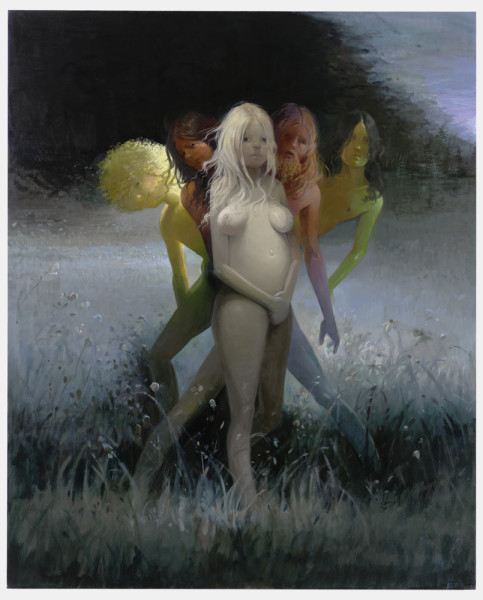Jarett Earnest opened his lecture with a thought provoking comparison between two art pieces from unexpected origins — Giovanni’s Madonna and Child and “Rorschach Blot” by Lisa Yuskavage. These two briefly mentioned artists would reoccur over and over throughout his talk, often with links being drawn between the two seemingly unrelated practitioners of art. Earnest occurs as down to earth, witty, and unwilling to put on an all to often contrived ‘high art’ mystique. The market-driven, faddish nature of the Art World of New York City was briefly called to stand, specifically the current obsession with object oriented ontology— a study that is clearly not important to his own critique methods. I appreciated his little quips at the ever fabricated and skin deep state of art markets. He also seemed willing to open himself up to embarrassment, and concsiously show a certain level of immaturity (and genuine wonder) in his approach to viewing artworks. Although he seemed in tune with some technical aspects (color theory, general composition of shapes), he wasn’t bogged down by a mountain of overused art critique tropes. Overall, I found his personality refreshing.
Earnest’s approach to evaluating and in some ways quantifying the paintings which he displayed was somewhat simple. Perhaps a little too simple. I enjoyed, however, that he made his thought process digestible by honing in on just a few aspects which he truly admired about the two previously mentioned artist’s works. Color use, emotional/ psychological implication, and religious connotation were some of his main concerns when dissecting art during his lecture.
Earnest provided his thoughts on the usage of trigger warnings, especially when it comes to art, arguing that “art should have weird, disturbing subject matter because life does.” I’ve personally become disenchanted with the widespread propagation of political correctness. There is a point where we depart from just respecting one another to censoring one another. Art, especially, shouldn’t be limited to a range of PC values. Earnest links our general numbness to and fear of emotion to PC culture, as well as our overuse of technology. We lack real, face-to-face, honest communication nowadays. This has potentially disastrous effects for artistic communication as well.
Moving on and beginning the more conceptual part of his lecture, Earnest describes his recent experiences in Rome and iconic Roman art museums. He explains how he started viewing art in a time like he never had before, where each piece might only exist in that moment for him because he might never return to that spot. This state of viewership provided a whole new level of meaning. Earnest discusses the psychological and emotional urgency imbedded in Greco-Roman religious artworks — how they were intended to overwhelm audiences, and perhaps convince them to attend places of worship and become zealots themselves. After going through countless of these intensely evocative ‘in your face’ kind of works, Earnest stumbled upon Giovanni’s Madonna and Child, in direct contrast. The piece occurs with a conventional, nuanced beauty, where baby Jesus’ head “glows like a bowl of milk being hit by moonlight”.
Earnest compartmentalizes aspects of the painting, explaining some contexts of its creation and its storytelling. Much of his assessment is very subjective to his own interpretation, and some I didn’t relate to at all. Nonetheless I enjoyed his evaluation of the piece (and other Giovanni’s in a similar vein) and how he correlated them to contemporary works by painter Lisa Yuskavage.
Yuskavage’s work existed in an enticing zone somewhere between pop and classical painting. It had a sleekness and compositional simplicity, but also (as Earnest discussed) a basis in complex color theory and some beautiful, classic technique.
Earnest spends a good amount of time elucidating his ideas on color and color’s paradoxical relationship to many things, such as language. Wherein we can only apprehend color through language — It can’t be described any other way. Also, there are very few things in world that don’t change color over time. Earnest says twice, “there’s something profound about that”. His fascination with color entered a religious context when he associated color with the metaphysical realm. The concept of father, son and holy ghost, for example, imitate the relationship between primary colors. Earnest touches on duality as well, where opposite colors neutralize one another when combined to become grey. Painting with grey, also known as Grisaille, came up multiple times. I’d love to explore painting using only subdued colors more.



